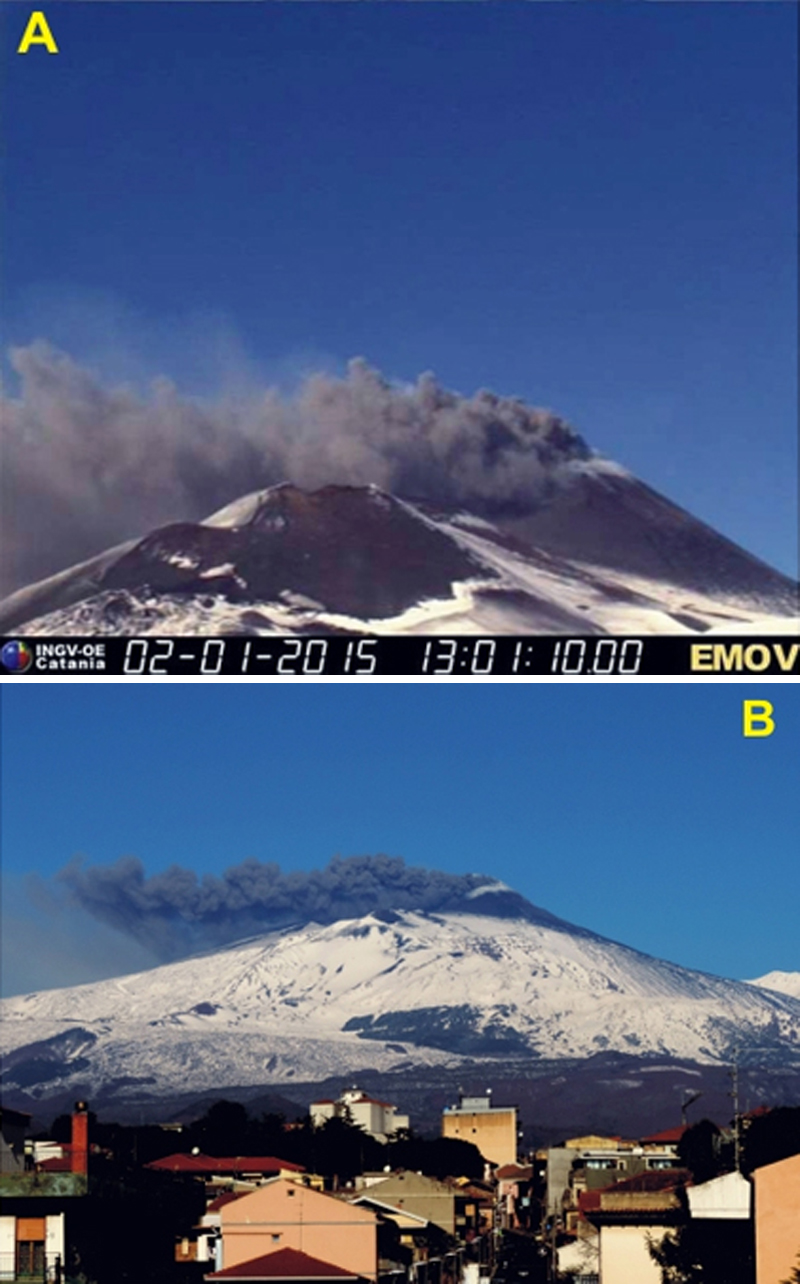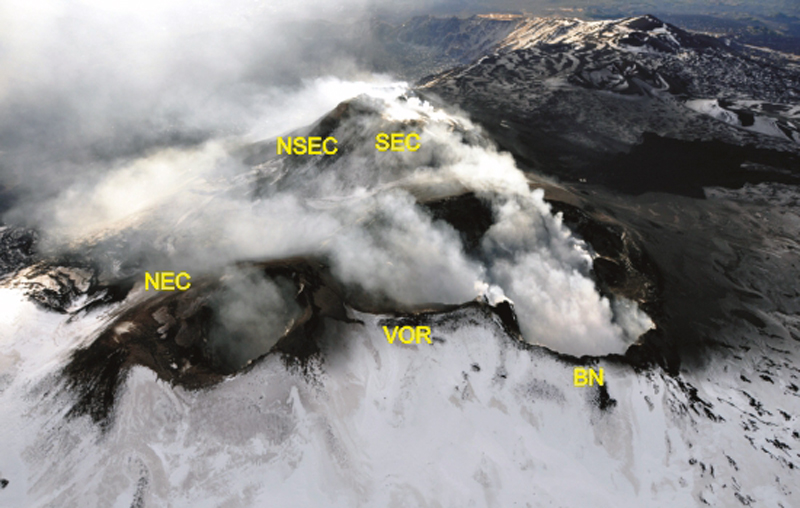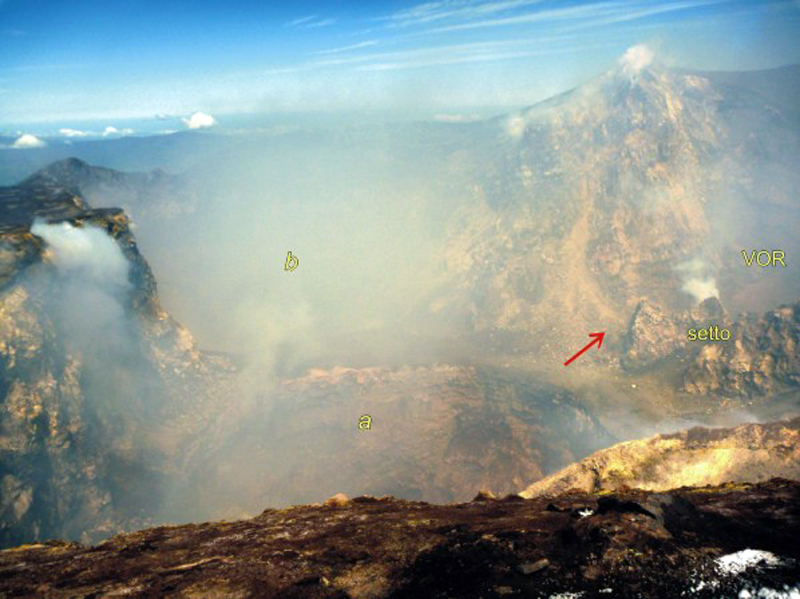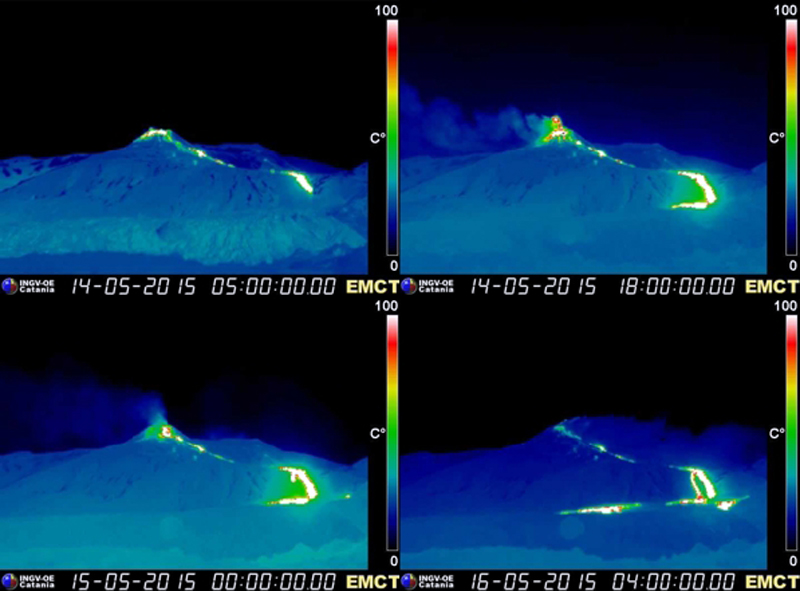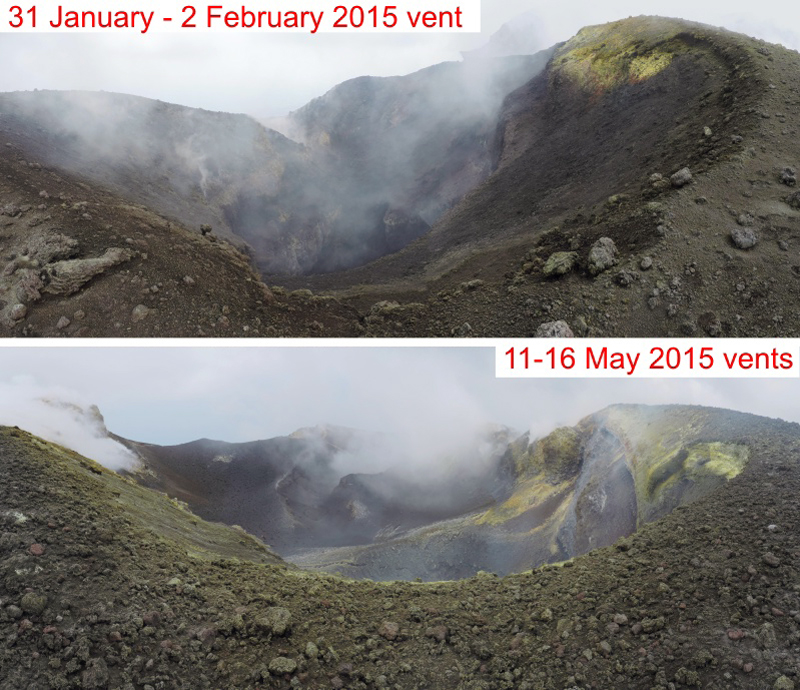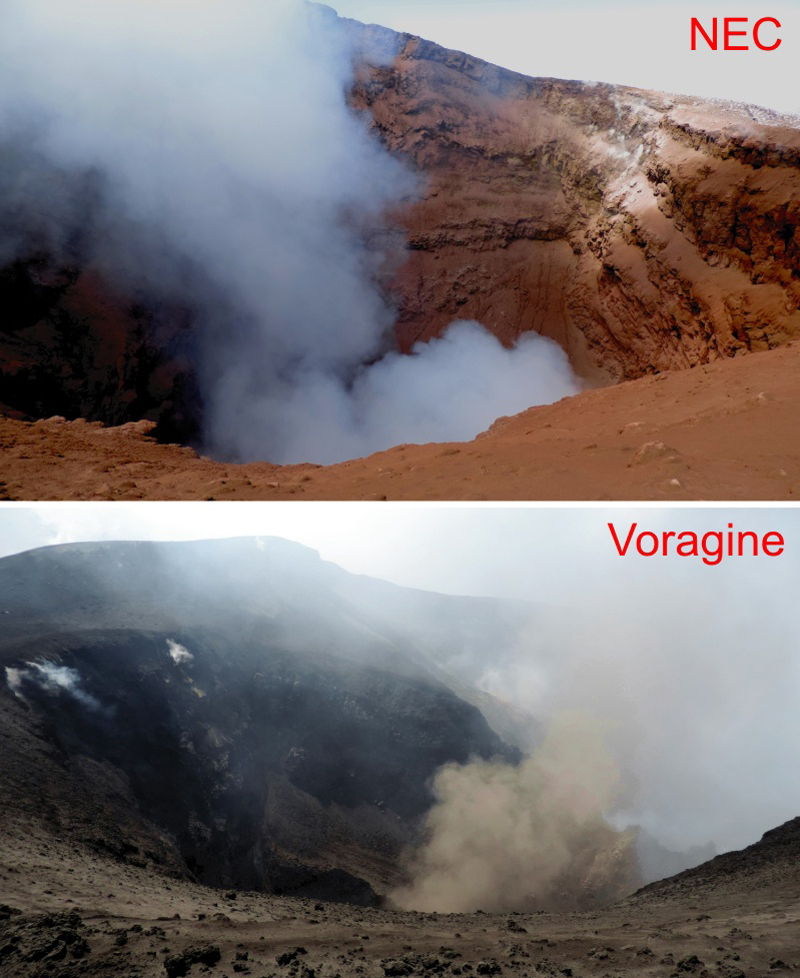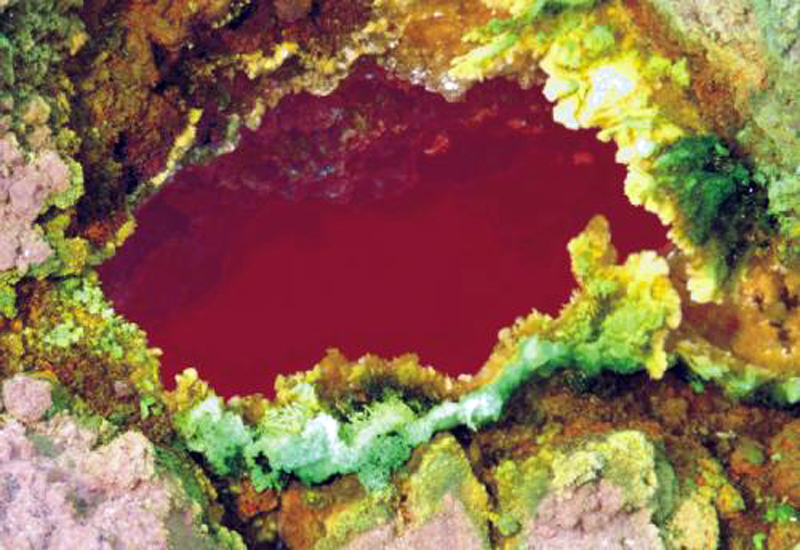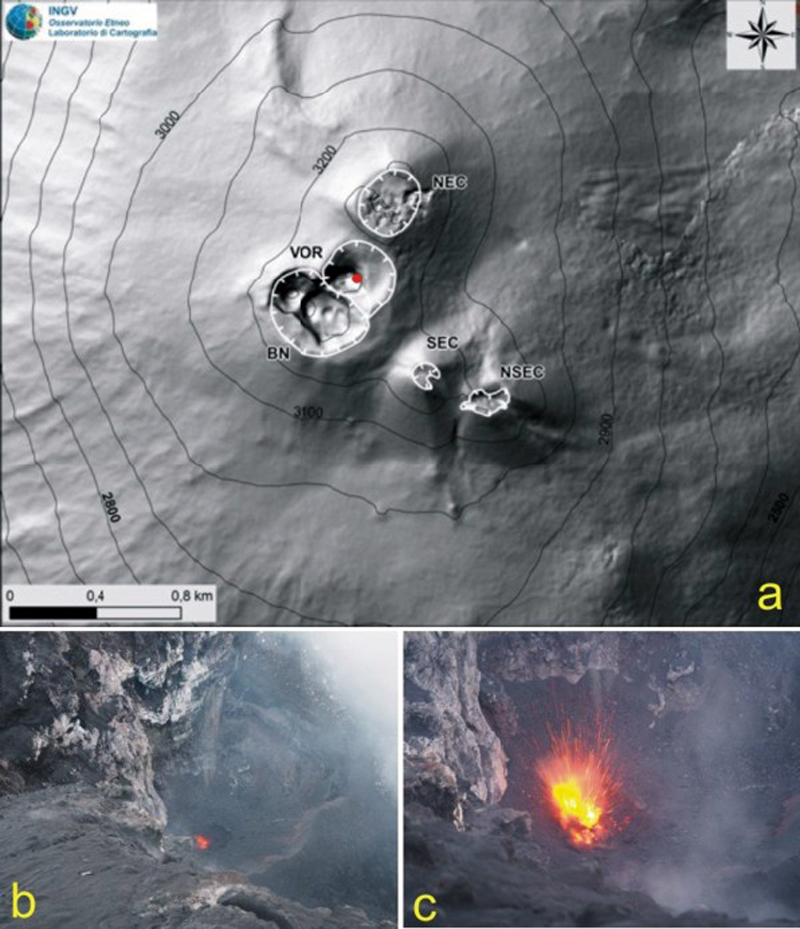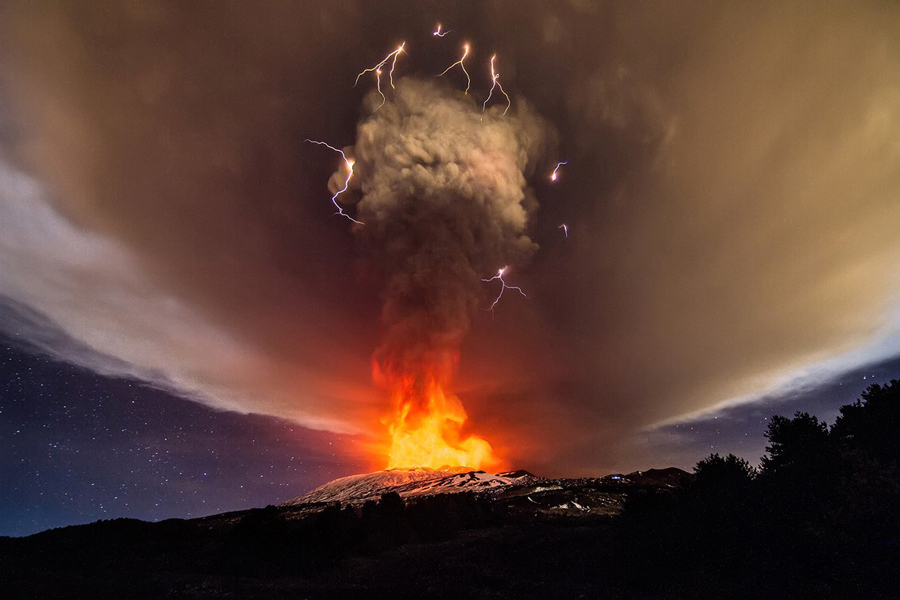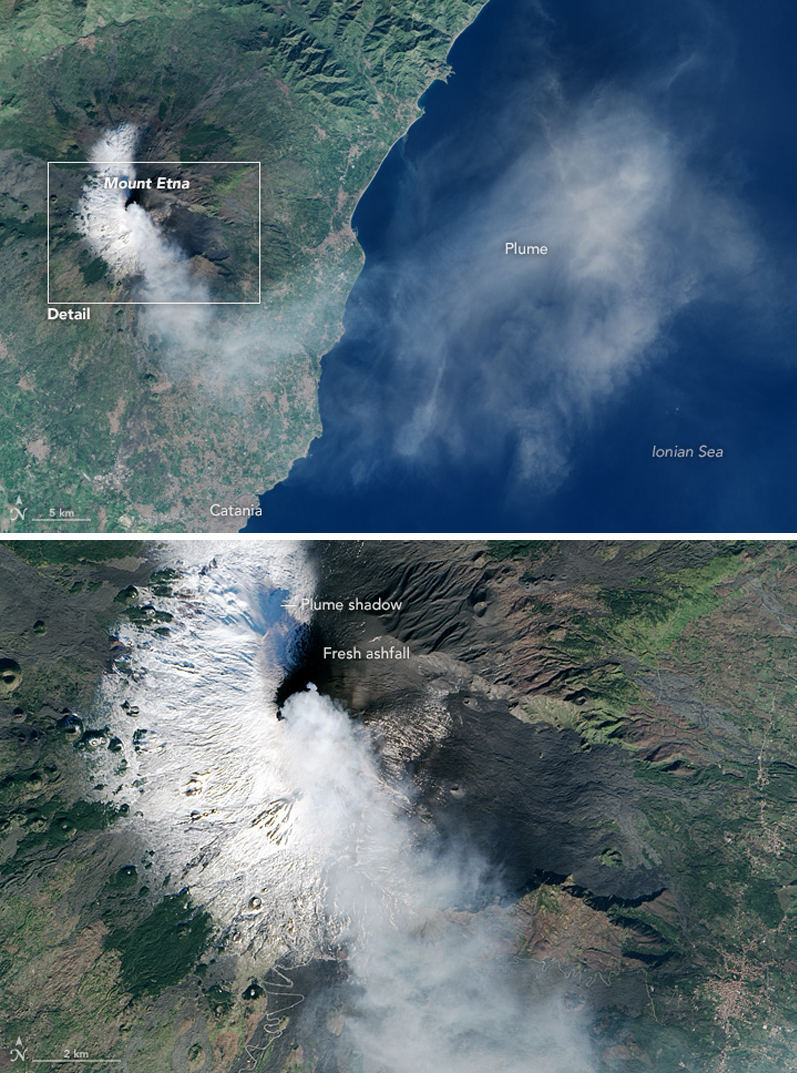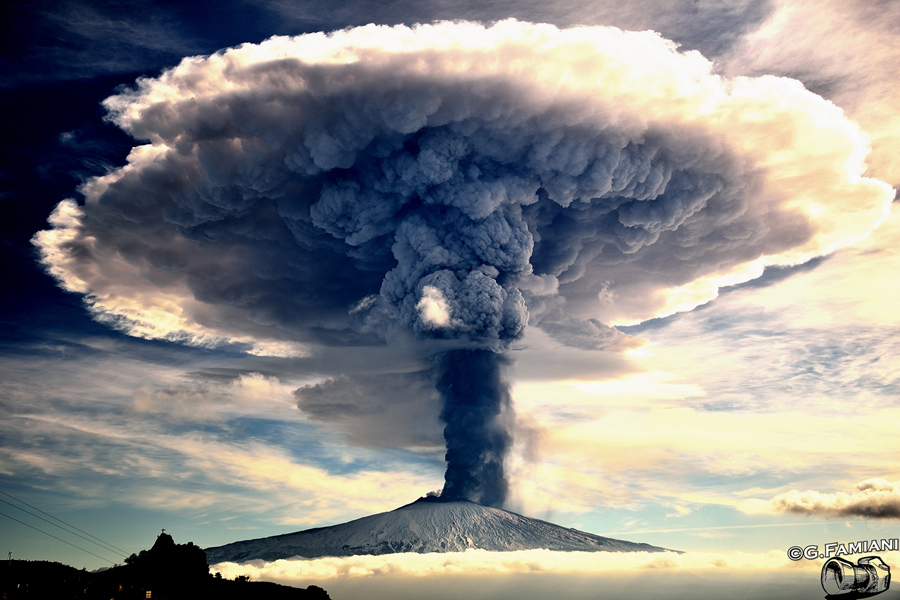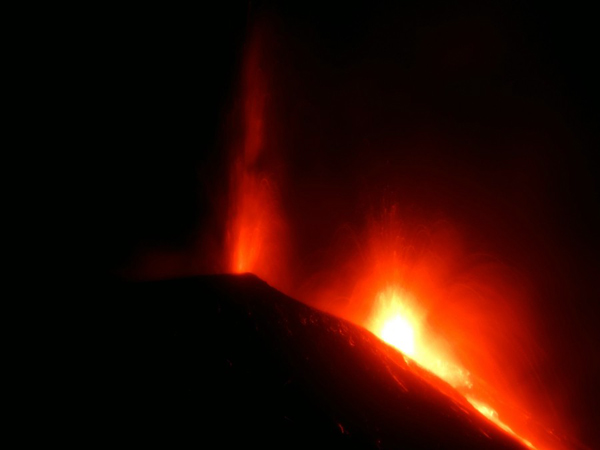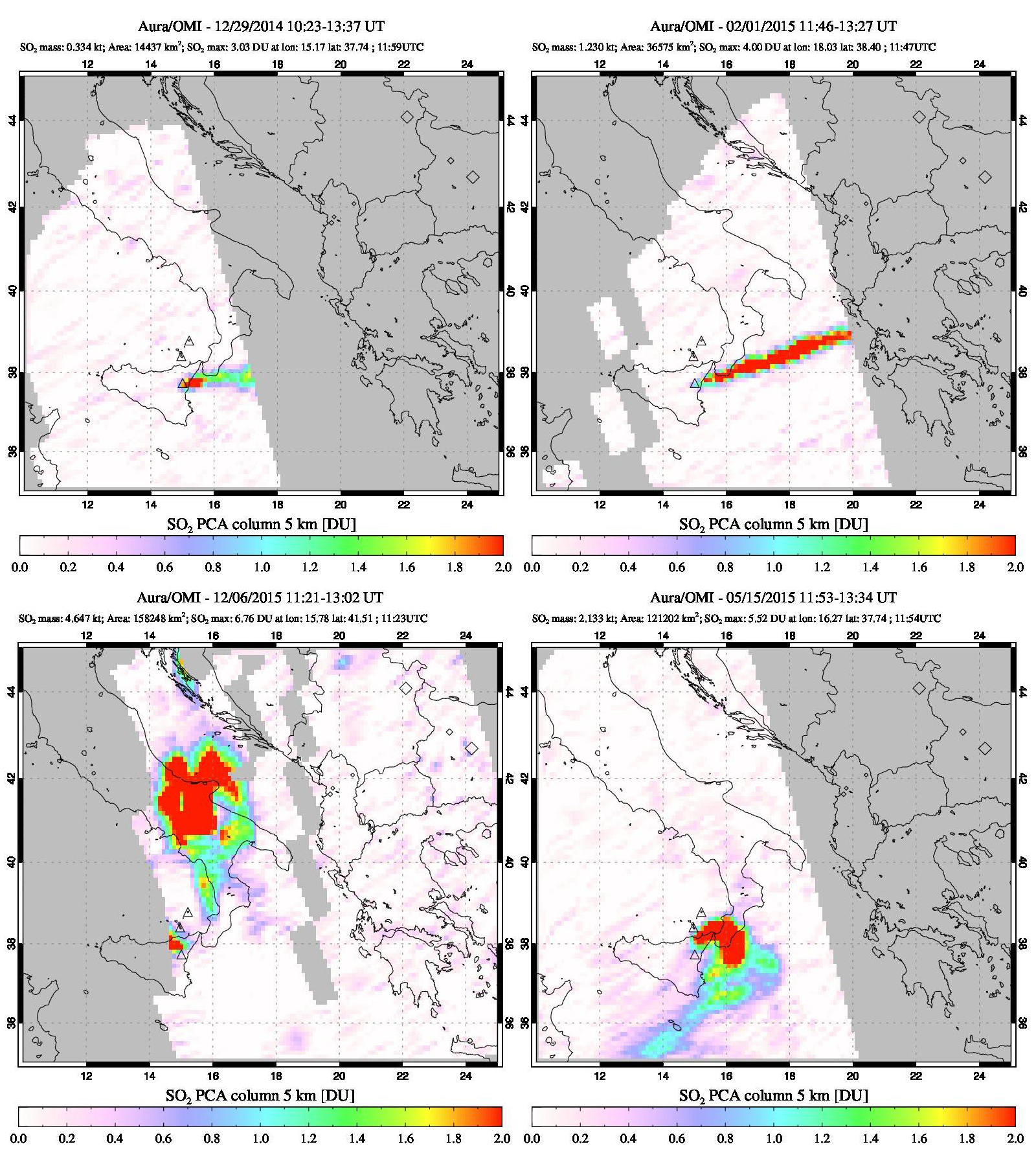Report on Etna (Italy) — May 2017
Bulletin of the Global Volcanism Network, vol. 42, no. 5 (May 2017)
Managing Editor: Edward Venzke.
Edited by A. Elizabeth Crafford.
Etna (Italy) Major eruptions with lava fountains, ash plumes, and lava flows during January-February, May, and December 2015
Please cite this report as:
Global Volcanism Program, 2017. Report on Etna (Italy) (Crafford, A.E., and Venzke, E., eds.). Bulletin of the Global Volcanism Network, 42:5. Smithsonian Institution. https://doi.org/10.5479/si.GVP.BGVN201705-211060
Etna
Italy
37.748°N, 14.999°E; summit elev. 3357 m
All times are local (unless otherwise noted)
Italy's Mount Etna on the island of Sicily has recorded eruptions for the past 3,500 years. Lava flows, and explosive eruptions with ash plumes and lava fountains, commonly occur from its four major summit crater areas, the North East Crater, the Voragine-Bocca Nuova complex, the South East Crater (formed in 1978), and the newest, the New South East Crater (formed in 2011). The Etna Observatory, which provides weekly reports and special updates on activity, is run by the Catania Branch of Italy's Istituo Nazionale di Geofisica e Vulcanologica (INGV). This report uses information from INGV to provide a brief summary of the major events during 2011-2014, and a detailed summary of events between January 2015 and March 2016. Major eruptions took place during 28 December 2014-2 January 2015, 31 January-2 February 2015, 11-16 May 2015, and 3-7 December 2015.
Summary of 2011-2014 activity. Most of the 44 eruptive episodes at Etna reported by INGV between 12 January 2011 and 2 December 2013 occurred at the New South Crater (NSEC) (figure 154) at the SE edge of the summit crater area. These eruptive events generally lasted for less than an hour and were characterized by sustained lava fountains accompanied by dense ash emissions and ejected pyroclastic material. Eruptive episodes occurred at Bocca Nuova (BN) in July 2011, July-August and October 2012, and January-February 2013. In addition, two weeks of intense Strombolian activity took place at Voragine (VOR) between late February and mid-March 2013. After an episode on 27 April 2013, Etna was quiet for six months until a large explosion on 26 October 2013 sent pyroclastic material several kilometers above the summit and caused a brief closure at the Catania airport. Two other episodes at NSEC during the middle and end of December 2013 were characterized by strong Strombolian activity, but without sustained lava fountains and fewer ash emissions.
During 2014, major activity was characterized by four events: 1) modest Strombolian activity and lava flows from the NSEC between 21 January and around 7 April; 2) intense Strombolian activity at NSEC accompanied by a lava flow to the SE during 14-18 June; 3) strong Strombolian explosions and lava flows from several vents between NSEC and the E flank of the North East Crater (NEC) between 5 July and 10 August; and 4) intense Strombolian activity at NSEC accompanied by a lava flow during 10-15 August. Weak explosive activity was also reported from NSEC during the second week of October.
Summary of December 2014-March 2016 activity. Activity from NSEC during 28-29 December 2014 created two major lava flows and an ash plume. During 31 January-2 February 2015 NSEC produced a new lava flow and several ash plumes. A minor ash emission from the BN crater took place on 12 April 2015. A large Strombolian eruption began at NSEC during the night of 11-12 May 2015, followed by a lava flow down the E flank on 13 May. Activity continued until 16 May. Minor ash emissions were reported from the NEC on 20 May, and again during 16, 18, and 19 July 2015.
The VOR crater released minor ash emissions on 20 and 24 August 2015, and again on 18 September. Small amounts of ash were also observed in a plume from NEC on 4 October. This was followed the next week by sporadic ash emissions from VOR which grew into persistent Strombolian explosions by the end of October and continued into mid-November. Strombolian activity at a new crater on the E flank of NSEC began on 25 November; ash emissions began there on 2 December 2015.
A major lava fountaining event from VOR began on 3 December 2015 which generated an ash plume that dispersed ash 70 km NE. This was followed by a 7-km-high (over 10 km altitude) ash plume the next day that sent ash to the E. Three more lava-fountain episodes took place at VOR over the next two days. After this the activity decreased at VOR but increased at NSEC with a 3.5-km-long lava flow on 6 December, followed by ash emissions and Strombolian activity. Sporadic ash emissions continued from VOR, NSEC, and NEC during December 2015-March 2016.
Activity during December 2014-February 2015. After four and a half months of relative quiet, with only minor ash emissions during 7-16 October 2014, the NSEC began a new eruptive episode on 28 December 2014 (BGVN 40:02). This was the 45th major episode at Etna since January 2011, according to INGV, and was characterized by lava fountains, lava flows in two different directions from a NE-SW trending fissure that crossed the NSEC (see figure 152, BGVN 40:02), and a tephra plume that drifted to the E. INGV calculated a volume of lava from the 28-29 December event, based on a lava thickness of 1.5-2 m, of about 3 x 106 m3. Coarse ash and lapilli as large as 4-5 cm were reported in Fornazzo (9 km E), and mostly coarse ash and fine lapilli were deposited in Giarre (15 km E). Fine ash was also reported in Linguaglossa 17 km NE.
Explosive activity at NSEC resumed on 2 January 2015 with dense continuous ash emissions lasting until the next day that dispersed SW (figure 155). During the night of 1-2 January, INGV also observed new Strombolian activity from VOR for the first time in two years. During the next week, incandescent pyroclastic material rose up to 150 m above the crater rim and occasionally fell outside the crater onto the W and SW flanks; this was accompanied by minor ash emissions rising a few hundred meters. MODVOLC thermal alerts were issued nine times between 5 and 10 January. Strombolian and ash plume activity resumed at the NEC on 14 January for a few days (figure 156), but clouds obscured the summit area for most of the rest of the month. Intense degassing and minor ash was seen during clear weather through 31 January.
A sudden increase in volcanic tremor amplitude in the early morning of 31 January 2015 indicated a new ash emission from the summit which was obscured from view by clouds. Later in the morning, fine ash fell over the snow in Rifugio Citelle (6 km NE). Strombolian activity was observed, along with a new lava flow moving to the SW, from the NSEC the next day. Sixteen MODVOLC thermal alerts were issued during 1-2 February while the lava flow was active. A field survey on 2 February determined that the lava front had stopped at 1,950 m elevation near the Monte Scavo area on the SW flank (figure 157). An ash emission occurred at NSEC in the early morning of 2 February; only persistent degassing was observed from the summit craters for the remainder of February.
Activity during March-September 2015. Degassing continued from the summit craters through March 2015 as viewed during limited clear weather. A high-temperature fumarole was observed in an infrared camera image on the E edge of NSEC on 29 March. The next ash emission occurred on 12 April from Bocca Nuova; it produced a plume a few tens of meters high that drifted SE, leaving fallout of fine reddish ash on the snow covering the western wall of the Bove Valley above 2,000 m elevation. A second smaller emission later in the day quickly dissipated.
A visit to the summit on 29 April 2015 confirmed persistent degassing from the craters. INGV scientists noted that the narrow septum separating the BN and VOR craters was much lower in height and broken through at the base, compared with earlier visits (figure 158). A small brownish-red ash plume on 1 May rose from BN; it likely resulted from a collapse inside the NW crater wall.
A Strombolian eruption began during the night of 11-12 May 2015 from the central part of NSEC. By midnight, the activity was strong enough to send tephra out of the crater and onto the flanks. A new lava flow appeared from a fracture just below the rim on the NE side early on 13 May; it generally followed the path of the 28 December 2014 flow to the NE. This was followed by increased ash emissions later in the day. The lava flow continued to advance NE during 14 May, into the Valle del Leone, and crossed near Monte Rittmann, flowing rapidly down the steep slope connecting the Valle del Leone with the Valle del Bove, headed towards Monte Simone (figure 159). By the end of the day it had traveled 3.5 km and was at 2,000 m elevation.
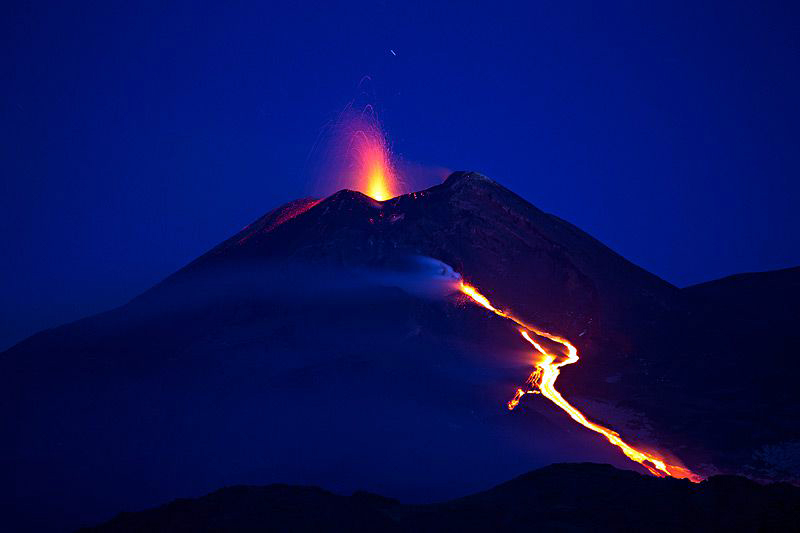 |
Figure 159. Early morning on 14 May 2015 reveals the lava flow on the NE flank of Etna from a fissure on the E flank. Photo by Emanuela/Volcano Discovery Italia; courtesy of Volcano Discovery. |
Intense Strombolian activity continued the next day at NSEC along with intermittent ash emissions. The lava flow split and flowed down the central part of the Valle del Bove, travelling 4.5 km to just below 1,800 m elevation. During the morning of 15 May a series of strong ash emissions lasting 2-3 minutes each continued from BN for about two hours. By the evening, the lava flow had traveled about 5 km and was at 1,700 m elevation (figure 160). Between 12 and 16 May, MODVOLC issued 103 thermal alerts for Etna.
By the morning of 16 May, volcanic tremor had diminished and Strombolian activity had ceased, but magma was still feeding the lava flow until the afternoon, when it tapered off. During the morning of 20 May there were sporadic brown ash emissions from the NEC. After this, variable amounts of degassing continued at the summit craters for a few months, with the NEC being the most active. This period of relative quiet permitted INGV scientists to make several surveys of the summit during July to document the effects of the recent eruptions on the craters (figures 161 and 162).
During a field visit on 16 July 2015, INGV scientists witnessed intense pulsating gas emissions and loud noises at NEC; the gas often contained small amounts of reddish fine-grained ash. Increased gas emissions on 18 and 19 July rose a few hundred meters above the summit and occasionally released appreciable amounts of reddish ash that covered the W flank of the crater. Small puffs with minor ash were intermittent for the next several days. Only degassing from the summit craters was observed until 20 August when minor ash emissions were noted from VOR. The next day increased seismicity was recorded at the summit area, but there were no visible surface effects. Frequent gas emissions that included minor ash were observed at the summit during a visit on 24 August (figures 163 and 164).
Degassing continued at the summit craters during September. The Montagnola webcam captured a minor ash emission from VOR on 18 September 2015. A glowing fumarole was observed inside the NSEC during a summit visit on 23 September 2015 (figure 165).
Activity during October-November 2015. Small but appreciable amounts of reddish ash which quickly dissipated were contained in a gas plume from NEC on 4 October 2015. Activity the following week (12-18 October) was characterized by sporadic, minor ash emissions from VOR; they were brownish-red, and were ejected during pulsating events that lasted for a few tens of seconds, repeating for as long as a few hours. Explosive activity was witnessed by a field crew at the bottom of VOR on 19 October. Lithic fragments and ashes were ejected in the immediate area of the crater. Activity increased at VOR during the end of October. During an inspection on 27 October, Strombolian explosions every 5-10 minutes sent incandescent pyroclastic material around the crater and produced minor ash emissions. A few bombs fell along the NW crater rim (figure 166).
On the morning of 2 November, after stormy weather conditions had blocked views of the summit for several days, volcanic ash was observed on the camera lens of the Montagnola (EMOV) webcam that was later washed away by rain. During a 4 November field survey, an ash deposit was discovered within layers of snow that fell between 31 October and 2 November on the upper part of the S flank (figure 167). The source of the ash remains unknown.
Modest Strombolian activity continued from the bottom of VOR during November 2015. A single small explosion occurred at the NSEC in the early hours of 8 November. During a 14 November field visit, INGV scientists observed intracrater explosive activity continuing at VOR which included several explosions with abundant ash emissions, interspersed with periods of strong spattering. On the E rim of the crater, several fresh, large (40 cm) clasts of volcanic debris had fallen as far as 12 m from the edge of the rim (figure 168).
By the third week in November 2015, ash emissions from VOR were more frequent and reached high enough levels to be visible from the webcams on the S slope. Lapilli and bombs rising more than 10 m above the northern edge of VOR were observed on a site visit on 19 November. During 20 and 21 November, a slow and gradual increase in the magnitude of volcanic tremor was noted, but there was no visible change at the summit. Weak Strombolian activity began at NSEC on 25 November and was observed in the Montagnola webcam. This led to the formation of a new "pit crater" located a few tens of meters below the E edge of the NSEC, with a diameter of 15-20 m.
Eruption of 2-8 December 2015. While on a site visit to VOR on 2 December 2015, INGV observed continuing Strombolian explosions with material ejected tens of meters above the crater rim; the cone at the bottom of the crater had continued to grow from the previous week. An explosion at the NSEC pit crater in the afternoon generated minor ash emissions, and Strombolian activity at VOR increased in the evening. A progressive increase in explosive activity began at VOR on 3 December. In the early morning, a lava fountain reached heights well over 1 km (figure 169) above the crater rim.
An ash plume from this eruption initially drifted NE; ashfall was reported in Linguaglossa (17 km NE), Francavilla di Sicilia (20 km NE), Milazzo, Messina (70 km NE) and Reggio Calabria (70 km NE) (figure 170). Weak and sporadic ash emissions also occurred from the NSEC pit crater. INGV reported this as one of the most intense and among the largest eruptions from Etna in the last twenty years, similar to events on 22 July 1998 and 4 September 1999. After about one hour, activity diminished and returned to less intense Strombolian activity.
The explosive activity at VOR intensified again around 0900 UTC on 4 December, with renewed lava fountains and an ash plume that rose 7-8 km above the summit (10-11 km altitude); this episode lasted until about 1025 UTC (figure 171). Ash emissions continued throughout the day from the NSEC as well. Bombs and lapilli were deposited high on the SW slope above 2,000 m elevation. Ashfall was reported in the Giarre-Zafferana area 17 km E. Strombolian activity continued for much of the day at VOR until 2000 UTC, when the third lava fountain (since 3 December) erupted that lasted for about 90 minutes before subsiding again to less intense Strombolian activity.
A fourth episode of lava fountaining from VOR took place mid-afternoon on 5 December 2015 and lasted for about 60 minutes. After this, activity decreased (both ash emissions and Strombolian explosions) from VOR, but increased at the NSEC pit crater, which grew due to continuous activity. In the early morning the following day two pyroclastic flows descended a few hundred meters toward the Valle del Bove. Around 1700 UTC, INGV personnel observed two lava flows, fed from the NSEC, headed toward Valle del Bove; one headed E for 3.5 km and reached 2,100 m elevation, and the other advanced ENE a few hundred meters to 2,600-2,700 m elevation. The easternmost vent at NSEC began emitting dark ash plumes on 7 December along with Strombolian activity that evening (figure 172). Activity at NSEC lasted for about 48 hours, ending in the morning of 8 December.
Activity during December 2015-March 2016. Ash plumes accompanied by sporadic Strombolian activity were ejected from the NEC beginning on 7 December, and lasting intermittently through 14 December. Renewed explosions on 13 December at NSEC produced ash emissions, minor incandescence, and thermal anomalies. MODVOLC reported 84 thermal anomalies at Etna between 2 and 9 December.
INGV scientists observed on a 12 December visit that the BN and VOR craters were essentially joined into a larger, single crater after the early December explosions, similar to the former Central Crater at Etna. VOR was covered with tens of meters of pyroclastic debris. The debris also covered much of the rest of the summit area, including the lava flows from the previous winter. The parking lot of the visitor area, located 0.5-1 km W and NW of VOR, was marked with numerous impact craters several meters in diameter.
Two minor ash emissions occurred at VOR on 19 December. After that, only steam emissions were observed at the summit until 28 December when a new series of ash emissions with minor incandescence were ejected from the vent on the E flank of NSEC. They were sporadic over the next several days and had ceased by 8 January 2016. Trace amounts of ash were again reported from the E flank vent during the last days of January 2016 and on 6 February. During this time, emissions from NEC often contained trace amounts of ash. Modest amounts of brown ash were observed from the NEC in the morning of 9 February.
An explosive event at NEC on 23 February created an ash plume tens of meters high which drifted N and rapidly dissipated. Lightning was observed in the ash cloud. Ashfall was reported in Linguaglossa, Gaggi, and Santa Teresa Riva (40 km NE) from this event. A new emission on 25 February consisted of several pulses of medium-low intensity that produced a very dilute ash plume a few meters above the crater. During March 2016, sporadic ash emissions at NEC accompanied persistent degassing, but there were no reports of ashfall other than in the immediate area of the crater.
Sulfur dioxide data. Numerous images of SO2 emissions from Etna during this period were captured by the Aura instrument on NASA's OMI satellite. Emissions during the four major eruptive events discussed in this report (28-29 December 2014, 31 January-2 February 2015, 11-16 May 2015, and 2-7 December 2015) were the largest (figure 173).
Geological Summary. Mount Etna, towering above Catania on the island of Sicily, has one of the world's longest documented records of volcanism, dating back to 1500 BCE. Historical lava flows of basaltic composition cover much of the surface of this massive volcano, whose edifice is the highest and most voluminous in Italy. The Mongibello stratovolcano, truncated by several small calderas, was constructed during the late Pleistocene and Holocene over an older shield volcano. The most prominent morphological feature of Etna is the Valle del Bove, a 5 x 10 km caldera open to the east. Two styles of eruptive activity typically occur, sometimes simultaneously. Persistent explosive eruptions, sometimes with minor lava emissions, take place from one or more summit craters. Flank vents, typically with higher effusion rates, are less frequently active and originate from fissures that open progressively downward from near the summit (usually accompanied by Strombolian eruptions at the upper end). Cinder cones are commonly constructed over the vents of lower-flank lava flows. Lava flows extend to the foot of the volcano on all sides and have reached the sea over a broad area on the SE flank.
Information Contacts: Sezione di Catania - Osservatorio Etneo, Istituto Nazionale di Geofisica e Vulcanologia (INGV), Sezione di Catania, Piazza Roma 2, 95123 Catania, Italy (URL: http://www.ct.ingv.it/it/); Hawai'i Institute of Geophysics and Planetology (HIGP), MODVOLC Thermal Alerts System, School of Ocean and Earth Science and Technology (SOEST), Univ. of Hawai'i, 2525 Correa Road, Honolulu, HI 96822, USA (URL: http://modis.higp.hawaii.edu/); NASA Earth Observatory, EOS Project Science Office, NASA Goddard Space Flight Center, Goddard, Maryland, USA (URL: http://earthobservatory.nasa.gov/); NASA Goddard Space Flight Center (NASA/GSFC), Global Sulfur Dioxide Monitoring Page, Atmospheric Chemistry and Dynamics Laboratory, 8800 Greenbelt Road, Goddard, Maryland, USA (URL: https://so2.gsfc.nasa.gov/); Erik Klemetti Eruptions Blog, Wired (URL: https://www.wired.com/author/erikvolc/); Tom Pfeiffer, Volcano Discovery (URL: http://www.volcanodiscovery.com/).



